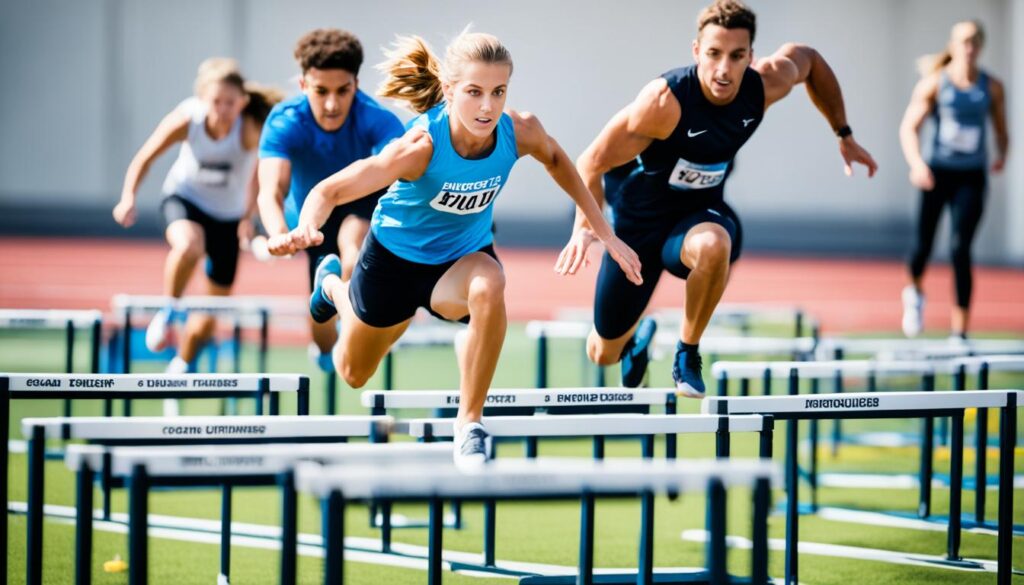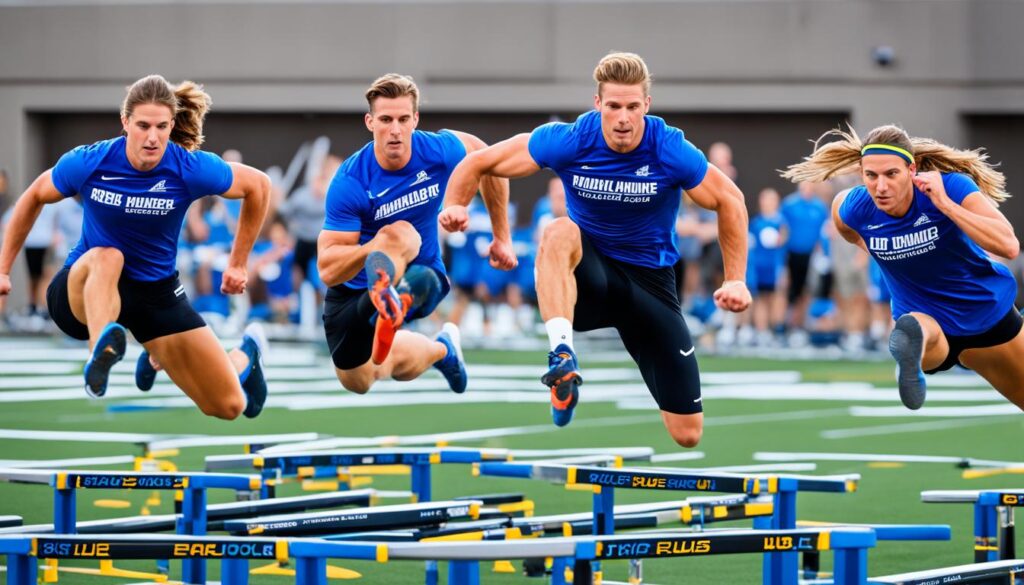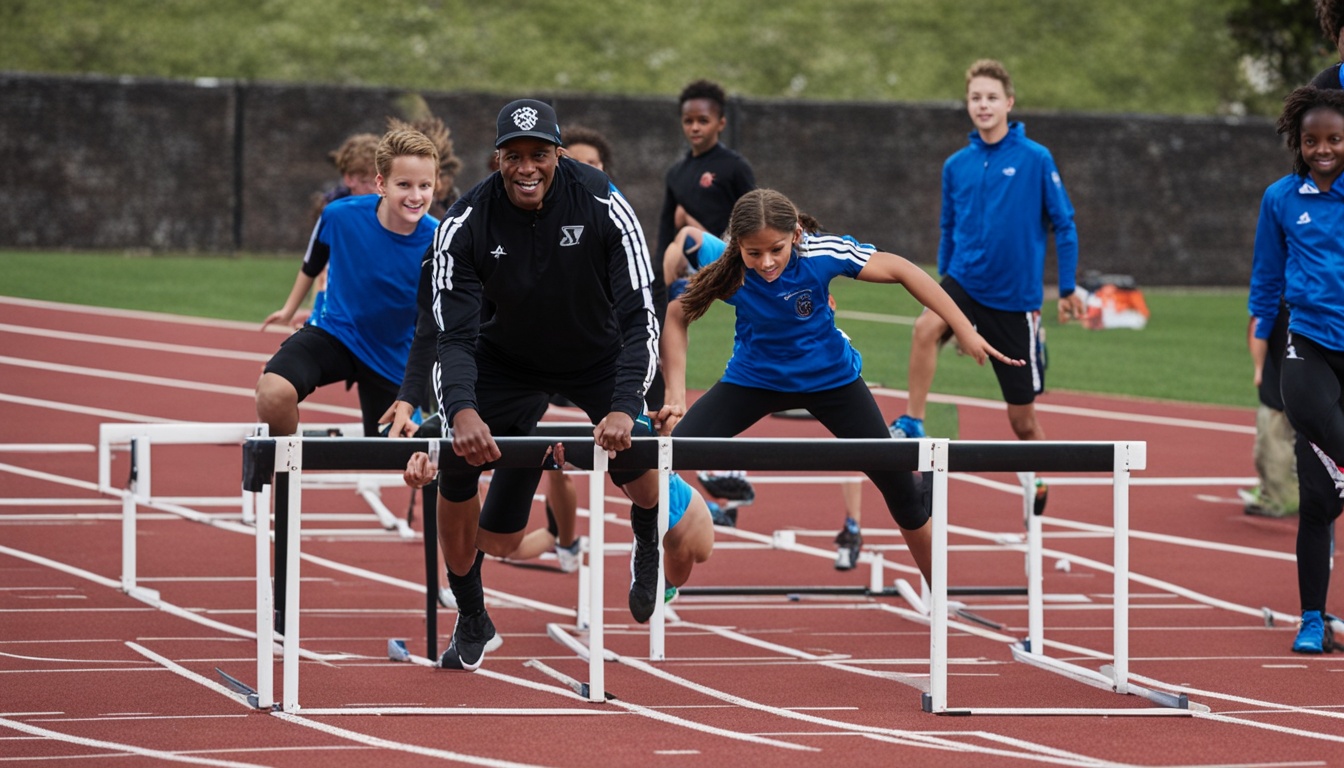“As an Amazon Associate I earn from qualifying purchases.” .
Ever thought you could jump over obstacles like a gazelle? Welcome to the exciting world of hurdling! This guide will show you how to teach hurdle techniques, turning beginners into track stars. If you’re a new coach or an athlete wanting to beat those hurdles, you’re in for a great experience.
Hurdle coaching is more than just clearing bars; it’s an art that combines speed, agility, and precision. You’ll see that height isn’t everything in this sport. Remember Renaldo Nehemiah? He was only 5’9″ in high school but became a legend in hurdling. It’s about finding that spark in athletes – their quickness, power, or the desire to fly over hurdles.
This guide is for beginners in hurdle training. We’ll cover how to spot potential hurdlers, learn the basics, and develop key skills. You’ll understand why flexibility is crucial in hurdling and how to help your athletes improve it. So, put on those spikes and get ready to dive into the thrilling world of hurdles!
Key Takeaways
- Height isn’t crucial; look for quickness, speed, or power in potential hurdlers
- Flexibility is an underrated but essential attribute for successful hurdling
- Proper technique focuses on sprinting, leading with the knee, and maintaining square hips
- Effective coaching involves identifying athlete potential and tailoring training accordingly
- Gradual progression in hurdle height and distance is key for beginners
Introduction to Hurdling: Breaking Down the Basics
Are you ready to dive into the world of hurdling? Let’s start with the basics that will help you clear those hurdles easily. Remember, hurdling is different from regular sprinting, so forget what you know!
In hurdling, you sprint on your toes, lead with your knee, and keep your hips straight. It’s like dancing, but faster and with hurdles. Aim for a smooth action over low hurdles while running fast. Imagine you’re a gazelle jumping over obstacles, but on a track.
Let’s look at the numbers. Most men in high school and college take eight steps to the first hurdle. Women usually take eight steps too. But, if you’re fast and brave, trying a seven-step approach could be your winning strategy.
| Gender | Common Step Count | Optimal Distance at 4th Step |
|---|---|---|
| Male | 8 steps (some 7) | 4.52 – 4.71 meters |
| Female | 8 steps (some 7 or 9) | 4.52 – 4.71 meters |
Learning the right technique is key. Your takeoff for the first hurdle is as important as a long jumper’s jump. Push off slightly early, move your hips past your foot, and make a smooth curve. And remember, bring your lead leg down after clearing the hurdle – you’re not jumping high here!
“Hurdling is just sprinting with attitude.”
That’s the basics of hurdling in a nutshell. Now, go out there and show off your skills like a pro!
Identifying Potential Hurdlers: Key Qualities to Look For
Finding talent in hurdle coaching is more than just looking at height. Athletes of all sizes can excel in hurdles. For example, Renaldo Nehemiah, the top hurdler ever, was only 5’9″ in high school.
Work Ethic and Determination
For beginners in hurdle training, a strong work ethic is key. You’ll face many challenges and frustrations. But, those who keep going often find success. Coaches want athletes who are willing to work hard to master this tough event.
Aggression and Fearlessness
Hurdling requires aggression. Athletes from football, like wide receivers and defensive backs, often do well because they’re fearless. This fearlessness helps them confidently take on the hurdles.
Desire to Hurdle
What’s most important? A real desire to hurdle. Many athletes are drawn to the event’s unique challenges. Renaldo Nehemiah says it’s not just about fast times. It’s about the feeling of moving smoothly and effortlessly through the hurdles, making hurdling an art form.
Physical Attributes Beyond Height
Height helps, but it’s not the only thing. Look for these key physical traits:
- Quickness
- Speed
- Power
- Flexibility

Dancers and gymnasts often do well in hurdles because they’re flexible. Remember, athletes like Gail Devers (5’3″) and Perdita Felicien (5’4″) show that technique and determination beat height.
“The best hurdler I ever coached was only 5’10”, 140 pounds, and ran 14.21 in the 110 hurdles.” – Steve McGill
By focusing on these qualities, you’ll find athletes with the potential to excel in hurdles, even if they’re not tall.
The Fundamentals of Proper Hurdling Form
Mastering hurdle form is key to doing well in this tough track event. The basics of hurdle technique are vital for clearing obstacles efficiently and quickly. Let’s look at the main parts of proper hurdling form.
Sprinting on the Balls of Your Feet
Think of yourself as a gazelle moving swiftly across the savanna when you’re hurdling. You should stay light and quick on your feet. Sprinting on the balls of your feet helps you control your speed better. Don’t land on your heels or toes, as it slows you down and raises injury risks.
Leading with the Knee
See your lead leg as a catapult ready to push you over the hurdle. Drive your knee up and forward as you approach the obstacle. Keep it a bit bent as you go over. This keeps your momentum and cuts down on air time. The less time you’re in the air, the quicker you’ll hit the ground!
Maintaining Square Hips
Your hips are the core of your hurdle form. Keep them square and level during the whole motion. This keeps you balanced and powerful as you jump over hurdles. Picture wearing a belt with a big, shiny buckle – keep that buckle facing forward always!
Focus on these key hurdle technique basics to get a smooth, steady running action over obstacles. Practice these regularly, and you’ll soon be jumping over hurdles like a pro!
How to Teach Hurdle Techniques
Teaching hurdle techniques needs a step-by-step approach. To be a great hurdle coach, break it down into easy steps. Let’s explore a method that works well for this track event.
Begin by showing your athletes low objects at random spots. This makes them get used to jumping over things while running. Then, change these objects to match the right hurdle distances. This is key for building the right stride patterns.
After they’re comfy, move to modified hurdles. Have them run over low ‘foam-top’ hurdles. This is where the real hurdle coaching starts!
First, work on the lead leg. Have your athletes walk over low hurdles, focusing on the lead leg’s action. Then, focus on the trail leg. This step is crucial for staying fast between hurdles.
- Run over low objects at random spacings
- Adjust to correct hurdle distances
- Practice with modified hurdles
- Develop lead leg technique
- Master trail leg action
Finally, put everything together into one skill. Start your athletes from the blocks, running over two hurdles. Gradually add more hurdles and increase their height as they get better.
Remember, learning hurdle techniques takes time. Watch out for mistakes like hesitation or an incomplete trail leg. With regular practice and your help, your athletes will soon clear hurdles like pros!
Essential Drills for Developing Hurdling Skills
Want to improve your hurdling skills? Let’s explore some top-notch hurdle drills that will make you jump like a gazelle. These hurdle workouts focus on perfecting your technique and boosting your track confidence.

Walk-Overs and Fence Drills
Begin with walk-overs using 5-10 hurdles set at 30″-33″ high. This drill helps you get used to the motion and improves your form. Then, try fence drills! They’re great for practicing the trail leg action. You’ll soon swing that leg like a pro.
Lead Leg and Trail Leg Isolations
Now, let’s work on those legs separately. Set up five hurdles and practice lead leg and trail leg isolation drills. This method will help you master each leg’s movement, making your technique smoother.
Hurdle Shuttle Relays
It’s time for some fun competition! Hurdle shuttle relays are exciting and perfect for practicing your full hurdling action. Plus, they’ll get your heart racing like a caffeinated cheetah!
Remember, practice is key. These hurdle drills might be challenging at first, but keep at it, and you’ll clear hurdles like a pro. Just like mastering money, hurdling requires patience and persistence!
| Drill | Purpose | Recommended Reps |
|---|---|---|
| 1-Step Drill | Mimics full-speed hurdling | 7-8 steps between hurdles |
| Schery Tops | Improves cut step timing | 10-15 reps |
| Cycle Ladder | Develops quick feet and rhythm | 5-7 hurdles |
| Ladji Drill | Enhances lead leg speed | 8-10 reps per leg |
“Hurdling is not just about jumping high, it’s about mastering the art of controlled flight.”
Establishing Lead Leg Dominance
Mastering lead leg dominance is key in hurdling. You must focus on specific cues to develop this skill. Let’s explore some effective methods to improve your lead leg dominance and hurdle mechanics.
Begin by kicking a ball with your preferred leg. This action often shows your natural lead leg. Then, lean forward until you’re off balance. The leg you step forward with is likely your dominant lead leg.
Another technique involves a coach pushing you slightly from behind. Your body’s natural response shows your lead leg preference. You can also try bringing your knees to your hands by your chest. The leg that reaches your hands first is usually your dominant lead.
To improve your hurdle mechanics, add these drills to your training:
- Walk-overs: Practice stepping over low hurdles, focusing on lead leg action
- Banana Steps: Run over curved barriers to simulate race conditions
- Plyometric Power Hurdles: Use these to develop explosive power in your lead leg
| Drill | Purpose | Frequency |
|---|---|---|
| Walk-overs | Improve lead leg technique | Daily |
| Banana Steps | Simulate race conditions | 2-3 times per week |
| Plyometric Power Hurdles | Develop explosive power | 1-2 times per week |
Remember, getting lead leg dominance is just the start. You must work on both legs to be a well-rounded hurdler. As you get better, focus on keeping proper form and slowly increase the hurdle height to challenge yourself.
Mastering the Trail Leg Action
Getting your trail leg action right is key to improving hurdle technique. Let’s explore some strategies to boost your hurdle form and speed up your hurdling.
The “Dog and Tree” Technique
Imagine your trail leg as a dog lifting its leg at a tree. This helps you lift your leg to the side, keeping your heel near your butt. Then, push your knee forward in a high action. This method opens up your groin and keeps your form right.
Perfecting the Knee Drive
Work on driving your knee and heel up while keeping good hurdle form. Many beginners lift their trail leg under their hip, which makes them jump higher. Instead, push off the track powerfully and drive your trail leg forward right away.
Landing and Running Off the Hurdle
Think of a “balloon” under your foot as you go over the hurdle. This helps you place your foot right and move smoothly back into sprinting. Practice landing and moving off the hurdle in one smooth motion to keep your speed and rhythm.
Mastering the trail leg action takes time and effort. Use drills like walk-overs and pop-overs to build the right hurdle form. With hard work, you’ll see your hurdling skills and performance get better.
Teaching Proper Stride Patterns Between Hurdles
Mastering stride patterns is key in hurdle mechanics. Aim for a consistent three-stride rhythm between hurdles. This method boosts speed and efficiency, making you a better hurdler.
Start with shuttle hurdle relays. Use hurdles of different heights but keep the distances the same. This helps you adjust to various situations while keeping your stride pattern steady.
Begin with small steps. Use markers 3 to 6 feet apart, then increase to 10 sets. As you get better, widen the hurdle distance to match competition levels. For men’s 110m hurdles, hurdles are 9.14m apart. Women’s 100m hurdles are 8.5m apart.
Your takeoff should be about 2 meters from the hurdle. Your lead foot should land around 1.25 meters past it. Focus on these points to improve your form.
“Consistency in stride patterns is the secret sauce of hurdling. Master it, and you’ll fly over those barriers like a gazelle on steroids!”
Safety comes first! Don’t practice on wet or slippery surfaces. As you get better, raise the hurdle heights to fit your age and gender. Always focus on proper form over speed.
Introducing Race Distance and Competition
Are you ready to improve your hurdle practice? It’s time to explore race distances and competition! As you move forward in your training, you’ll face new challenges like the 300-meter hurdles. This event tests your speed, endurance, and technique.
Gradually Increasing Hurdle Height
Begin with hurdles at their lowest height all year. This helps you work on your form without the stress of high hurdles. As you get better, slowly increase the height. Top hurdlers often practice with hurdles one notch below race height, which is 36 inches for boys and 30 inches for girls.
Timing Runs and Building Confidence
Timing your runs is key to tracking your progress and gaining confidence. The 300-meter hurdles have 8 hurdles and five main parts. Aim to master each part to cut down your time. Start strong, aiming for full speed in 45 meters.
When you round the curve, focus on your technique and lean to keep up speed. By the end, you’ll be set to “slingshot” out of the curve and sprint to the finish!
FAQ
What qualities should I look for in potential hurdlers?
What are the fundamentals of proper hurdling form?
How can I teach hurdle techniques effectively?
What drills should I use to develop hurdling skills?
How do I establish lead leg dominance?
What’s the best way to teach proper trail leg action?
How should I approach teaching stride patterns between hurdles?
When should I introduce race distances and competition?
“As an Amazon Associate I earn from qualifying purchases.” .



